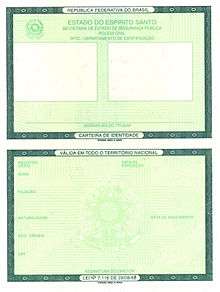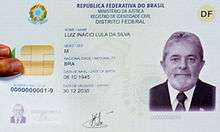Brazilian identity card

The identity card — called a cédula de identidade (identity card) cartão/carteira de identidade (identity card) or "RG" (from Registro Geral, General Registry) in Portuguese, depending on the state — is the official identity document in Brazil. It contains the name, the birth date, parents' names, signature and thumbprint of the bearer. Other national documents can legally be used as an identity card, such as the Brazilian driver's license, a Passport or, for minors, the birth certificate.
Issue
As it is needed for many activities, it is practically compulsory for all citizens who are of legal age (18 in Brazil) to have an RG card, although carrying it is optional though not uncommon. Minors may also obtain one but if the individual is under 16 at the time he or she applies for one, it will expire on his/her 18th birthday, making it necessary to apply for another one.
Identity cards are issued by the state governments and can be used nationwide. It is interesting to note that there is no legal restriction on having more than one identity card, provided that each one is issued by a different state.
The documents required for obtaining an identity card depend on whether the person is single, married or naturalized. For single persons, a birth certificate (the original or a certified copy) is used, for those who are married, the marriage certificate is used. As for the naturalized persons, a naturalization certificate is used. If the person so desires, the CPF can be printed on it too.
Security
Until the late 1980s, most identity cards were typed on stationery and photos were simply glued on it. Today, IDs are printed electronically with a scanned photo.
Legal Status
An identity card is needed to accomplish all legal formalities such as getting a driver's licence, opening a bank account, buying or selling real estate, financing debts, applying for a job, giving testimony in court, and entering some public buildings, etc. The police may ask to see the identity card of anyone who is arrested or searched. Not carrying one is not illegal but the police is entitled to escort a person without one in his or her possession to the police station for purposes of searching electronic police records for a criminal background check. As it is used for so many formalities, most Brazilians have one/carry one (though the law does not actually require it).
Several other documents are acceptable in lieu of the identity card, including, but not limited to, a driver's licence, passport, professional identity card from professional trade associations(e.g. the bar association identity card issued for lawyers, the physician's identity card issued by the medical board, and similar documents issued by the governing bodies of other professions such as for engineers, dentists, architects, etc.), military identity card, civil servant identity card or worker's registry, etc.
All documents accepted in lieu of a state-issued identity card bear a reference to the General Registration number of the state that issued the identity card. Thus, in order to have a passport, a professional ID, a driver's licence or any other kind of "substitute" ID issued, first a standard state-issued ID is required; only once an individual is registered at the standard General Registry can a substitute document be used although an individual may be registered at the General Registry in any of the country's states.
Appearance
There is a national standard but each state may have minor differences (usually numbering scheme, font, printed seal and background pattern). The standard is green, officially 102×68 mm.[1] It used to be laminated plastic, which made it slightly larger than the ISO/IEC 7810 ID-2 standard of 105×74 mm, resulting in a tight fit in most wallets. Today the cards are no longer laminated and, in fact, laminating newer cards is forbidden, because these have information printed on the inside that can be read by machines, bearers may protect their IDs by storing it in a small plastic cover issued with the card.
Contents
Front:
- Registration number (can have verification digits or letters) and each state can design its own system
- Issue date
- Full name of the bearer
- Parents' names (the father above, the mother below)
- Birthplace (location, state OR country)
- Birth date
- Base document:
CN: Birth Certificate (Certidão de Nascimento) CC: Marriage Certificate (Certidão de Casamento) Portaria Ministerial MJ XXXX/XX (Ministerial Order - Ministry of Justice no. of Decree/Year of naturalization)
- CPF number
Back:
- State Coat of Arms
- The full name of state
- The name of state office that issued the document
- A 3x4cm photograph
- Thumbprint
- Signature or an observation cancelling it (for illiterate persons)
Portuguese Citizens
The Brazilian Citizen RG is also issued to Portuguese Citizens benefiting from equal citizenship status, but with the expression Nacionalidade portuguesa - Decreto nº 70.391/72 (Portuguese nationality - Decree 70.391/72) written on it.
Non-Citizens (foreign nationals)
Since 1938 foreigners living in Brazil are also required to have identity cards called through the National Foreign Registry (Registro Nacional de Estrangeiros). These special IDs are red or pink and issued by the Federal Police.
Future

Federal Law 9454/1997 determined the merging of the state-level registration systems into a future unified registry. This will likely necessitate migrating the RG numbers into a new RIC (Registro de Identidade Civil, Civilian Identity Registry) numbering system. The Brazilian Federal Police proposed a new ID card standard to go with the changes. The new card has security features to deter counterfeiting and will probably have an embedded chip, following the form factor of common smartcards an RFIDs.[2]
See also
- Andean passport
- Brazilian nationality law
- Brazilian passport
- Cadastro de Pessoas Físicas
- Visa requirements for Brazilian citizens
- Visa policy of Brazil
References
- ↑ "Official decree (in Portuguese)". Retrieved 2007-11-26.
- ↑ "Registro Único Identidade Civil".